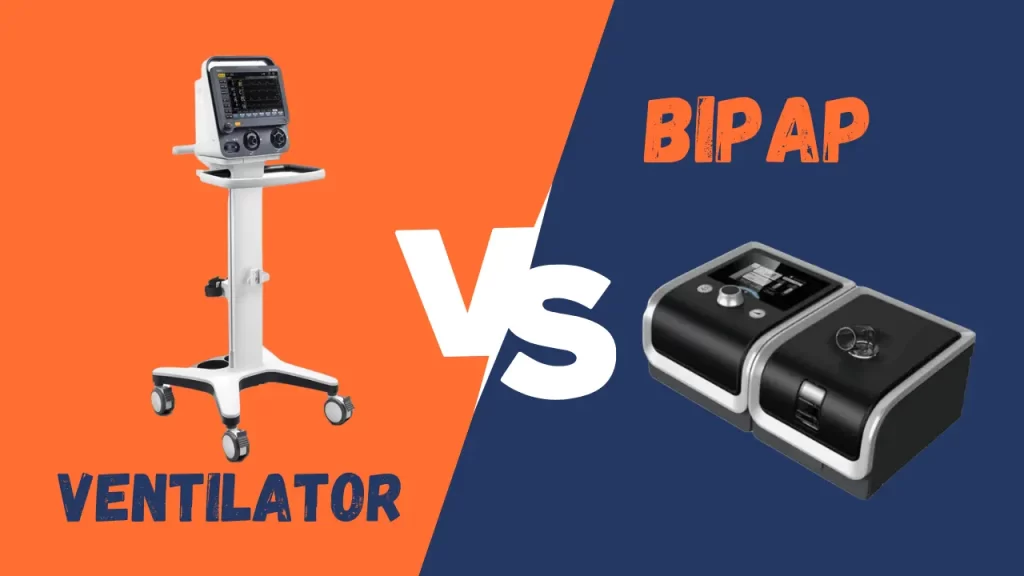Difference between Ventilator and BiPAP Machine
Breathing is one of the most essential things that humans do to stay alive. When a person’s ability to breathe is compromised, it can be a very scary and dangerous situation.
There are medical devices that can help people breathe when needed. Ventilators and BiPap machines are two devices used in medical settings to support people with their breathing.
In this article, we’ll discuss the differences between these two machines, their pros, and cons, so you can choose wisely.
What is a Ventilator?
A ventilator is a machine that helps a person breathe, typically when they are unable to do so on their own.
It provides fresh air into the lungs and removes carbon dioxide from the lungs.
Ventilators are most often used in hospitals and homes or in other settings.
Ventilators are used for short-term or long-term needs.
Someone with pneumonia may need a ventilator for a short period to recover, while someone with Amyotrophic lateral sclerosis (ALS) may need one for a longer period.
The type of ventilator needed will depend on the individual’s needs. There are many different types of ventilators available and each has its own advantages and disadvantages depending on the situation and the patient’s needs.
Some ventilators are smaller in size, making them easier to transport
others are more powerful, allowing them to provide higher levels of oxygenation; still, others have special features such as alarms that sound if something goes wrong or sensors that track vital signs such as heart rate and oxygen saturation levels.
Also, there are two main categories of ventilators—invasive and non-invasive.
Invasive ventilators have a tube cut into the skin.
Non-invasive models use masks that cover the nose and mouth.
Ventilators can be life-saving machines that provide essential breath support for people who cannot breathe on their own due to illness or injury.
With proper training and care, these machines can improve the quality of life for people with breathing difficulties caused by medical conditions.
What is a BiPAP machine?
BiPAP machines provide positive airway pressure ventilation for those who can’t breathe on their own. This type of machine works by delivering two different pressures
- Inhaling (higher pressure)
- Exhaling (lower pressure)
It helps the patient take deeper breaths, giving them more control over their breathing. Doctors set BiPAP machine settings based on age, weight, condition, and blood oxygen levels.
Some machines have high-tech alarms and sensors that track and record vital signs, such as heart rate, temperature, and blood pressure.
BiPap machines are used for respiratory failure, sleep apnea, COPD, asthma attacks, neuromuscular disease, or chest trauma/injury leading to impaired lung function.
They can also be prescribed by a doctor for long-term home care in special cases or premature infants too weak to breathe well independently.
BiPap machines are an effective way to help patients who have difficulty breathing due to various health conditions.
The two different pressures they provide allow the patient more control over their breathing while also providing assistance when necessary.
Settings can be adjusted according to individual needs, and some models come with extra features like alarms and sensors that measure vital signs.
BiPap devices are used in many situations including respiratory failure, sleep apnea, COPD, and more.

How do they differ?
Ventilators and BiPap machines, there are several important distinctions. Ventilators are designed to force air into the lungs while BiPap machines allow the patient to breathe on their own.
A ventilator is used When a person can’t breathe,
and BiPAP machines are used when a person can breathe but needs assistance.
Ventilators tend to have a higher price tag than BiPap machines due to their complexity and size.
Invasive Ventilators require more professional maintenance than BiPap machines as they are larger and heavier, making them difficult to move around if necessary.
Ventilators are significantly less portable than BiPap machines due to their size and weight.
Some newer ventilators are compact designs or have built-in wheels for mobility.
When choosing between a ventilator and a BiPap machine, consider all factors.
Knowing the differences between these two types of breathing aids will help you make an informed decision that best suits your particular situation.
Which one is Better for Certain Situations?
The type of equipment that is used will depend on the situation and needs of the patient.
Ventilators and BiPap machines are two types of medical devices used for respiratory support, but which one is better for certain situations?
Ventilators are used in more serious cases, like an acute respiratory failure.
When a patient cannot breathe on their own and requires oxygenation.
Ventilators are used in long-term situations such as chronic lung diseases or neuromuscular diseases.
Mechanical ventilation is mostly used in hospital settings, where they are closely monitored by trained staff.
BiPap machines, on the other hand, are usually only used for short-term support and can be used both at home and in hospitals.
They’re most useful for conditions like sleep apnea, COPD, asthma, or a chest injury that makes breathing difficult.
BiPAP machines provide positive airway pressure ventilation without requiring an incision as invasive ventilators do.
It’s important to know the difference between ventilators and BiPap machines so you can choose the best one for your situation. Before choosing a device, consult a doctor or specialist.
What are the pros and cons of each?
| VENTILATOR | BIPAP |
| High-Cost | Low-Cost |
| High Maintenance and only trained professionals can operate. | Low Maintenance, and it’s easy to operate |
| Ventilators are Larger and more Complex | BiPAP machines are smaller and simpler |
| It’s only used in Hospitals | It’s used in hospitals, clinics, and homes |
| Not easily transported from one place to another. | Easily Transported from one place to another |
| Higher Levels of Fresh oxygenation for the patient | Low level of fresh oxygenation for the patient |
In conclusion, while both machine types have benefits and drawbacks that must be weighed carefully before making a decision
Some cases may favor one over the other depending on the individual situation at hand. It is important to consider all factors to determine which type of machine would be most suitable for your specific requirements.





